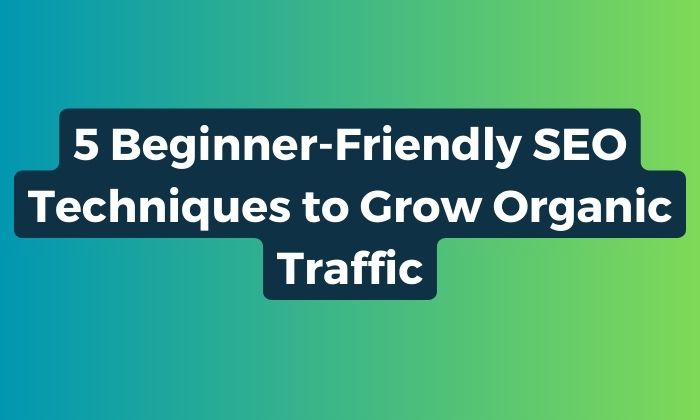
5 Beginner-Friendly SEO Techniques to Grow Organic Traffic
Table of Contents:
- Introduction
- Focus on the “People Also Ask” Section
- Study Your Competition
- Internal Links and Backlinks
- Refresh Outdated Content
- Pay Attention to Your Core Web Vitals and User Experience
- Conclusion
Introduction
Search engine optimization (SEO) is more than just a buzzword in the digital realm. It’s the backbone of visibility and the ticket to organic, non-paid traffic from search engines. Whether you’re a budding entrepreneur or someone looking to take their online presence up a notch, SEO is the key. But where does one start? This comprehensive guide will introduce you to five beginner-friendly SEO strategies, all tried and tested to increase organic traffic. As experts at Money Marketer, a digital marketing and SEO firm, we’ve witnessed the transformative power of these techniques firsthand.
1. Focus on the “People Also Ask” Section
“According to a study on Search Engine Journal, the ‘People Also Ask’ box appears in roughly 49% of Google search results.”
Google’s goal is to answer user queries as efficiently as possible. This drive has culminated in features like the “People Also Ask” section. It’s a gold mine for content creators.
- Understanding the Value “People Also Ask” offers additional queries related to the original search. By tapping into this section, you can address multiple user questions in one comprehensive piece, making your content more valuable. Neil Patel, a renowned digital marketer, explores advanced SEO strategies, including leveraging the “People Also Ask” feature, in his blog.
- Incorporation in Content Begin by typing a keyword related to your niche in Google. Review the “People Also Ask” dropdown. You’ll notice a series of questions. Craft content that answers these queries. Not only does this cater to a broader audience, but it also establishes authority. Ensure you integrate this with the overall theme of your digital marketing strategy.
2. Study Your Competition
“As stated by Single Grain, 90% of online marketers utilize competitor analysis tools to enhance their SEO strategies.”
Before you innovate, understand what’s already out there. Competitor analysis isn’t about imitation; it’s about differentiation.
- Using Tools for Insights Platforms like Semrush can offer a lens into your competitors’ strategies. Which keywords are they ranking for? What kind of backlink profile do they maintain? This understanding can be pivotal.
- Steps to Effective Analysis Start with a list of your main competitors. Plug their URLs into SEO tools like Semrush or Ahrefs. Look for patterns: common keywords, shared backlink sources, or similar content structures. By understanding these patterns, you can pinpoint gaps in your own strategy. Sites like Search Engine Journal provide in-depth guides on how to perform these analyses effectively.
3. Internal Links and Backlinks
“Semrush asserts that relevant, high-quality backlinks can boost a page’s traffic by up to 300%.”
Linking is the undercurrent of the internet. It’s how one webpage connects to another, directing traffic and spreading authority.
- The Power of Internal Links By using internal links, you ensure visitors spend more time on your website. Each link they click, if relevant, increases their stay. This not only offers SEO benefits but also increases the chances of conversion. It’s a method Single Grain emphasizes, among other actionable SEO techniques.
- Building a Backlink Profile Backlinks, or links from other websites to yours, act as endorsements in Google’s eyes. The more authoritative the site linking to you, the better. Tools can help identify backlink opportunities, but it’s also crucial to organically grow these by producing shareable content. Remember, it’s about quality, not just quantity. For detailed insights on building a credible backlink profile, refer to resources from 310creative.
With the foundational techniques laid out, in the following sections, we’ll delve deeper into more advanced strategies, ensuring a holistic approach to your SEO journey.

4. Refresh Outdated Content
“According to Single Grain, refreshing old content with new information can increase organic traffic by up to 111%.”
In the fast-paced world of digital marketing, what was relevant a year ago might not be today. Google prefers fresh, updated content, reflecting the most recent information available.
- Why Update? Outdated information can harm your website’s credibility. If users stumble upon old stats or recommendations that no longer hold, they might bounce off, increasing your site’s bounce rate. This not only harms user experience but also sends negative signals to search engines. Rejuvenating old content ensures you remain a reliable source in your niche.
- Methods to Identify Stale Content Tools like Google Analytics can be instrumental. Monitor pages with declining traffic or low engagement rates. These might be candidates for a refresh. Also, regular audits can help identify content gaps or topics that need revisiting.
- Updating Strategy After identifying the content, prioritize updates. Major industry shifts might require extensive overhauls, while minor trends could just need tweaks. When updating, consider embedding newer keywords, updating stats, and possibly reformatting for better user engagement. You can find more detailed strategies on how to effectively update content on Neil Patel’s blog.
5. Pay Attention to Your Core Web Vitals and User Experience
“Research from Search Engine Journal indicates that 88% of online consumers are less likely to return to a site after a bad user experience.”
In an era where user experience is paramount, website performance has become crucial. Google’s Core Web Vitals focus on three essential aspects of user experience: loading, interactivity, and visual stability.
- Deciphering Core Web Vitals Introduced by Google, these metrics aim to provide a holistic picture of a website’s health. They revolve around:
- Largest Contentful Paint (LCP): Measures loading performance. A good LCP ensures users aren’t waiting too long for content.First Input Delay (FID): Gauges interactivity. A swift FID ensures the site is responsive to initial user interactions.Cumulative Layout Shift (CLS): Assesses visual stability. A low CLS ensures elements on the page don’t shift unexpectedly.
- Enhancing User Experience (UX) While Core Web Vitals offer a technical perspective, overall UX is more holistic. It involves content layout, ease of navigation, and mobile responsiveness. Integrating these elements seamlessly ensures users have a smooth journey on your website.
- Tools and Resources Google’s PageSpeed Insights can offer detailed reports on your website’s performance, highlighting areas of improvement. It integrates Core Web Vitals, providing a snapshot of where your site stands.
As we inch towards the conclusion, it’s essential to note that SEO isn’t a one-size-fits-all approach. The techniques highlighted here provide a starting point, but the journey involves constant learning, tweaking, and adapting. In the next section, we’ll wrap things up and provide additional resources to aid you on your SEO quest.

Conclusion: Navigating the SEO Landscape
Search Engine Optimization, while technical, is grounded in one fundamental principle: providing value. Whether you’re optimizing meta descriptions or improving site speed, the end goal remains to enhance the user experience.
- Iterative ProcessSEO isn’t a one-and-done task. With algorithm updates, shifting industry trends, and evolving user behaviors, it demands constant attention and adaptation. Using resources like Single Grain can provide updated techniques to stay ahead.
- The Importance of Learning and Adapting As with most digital undertakings, change is the only constant in SEO. Stay updated with reliable sources like 310 Creative to keep your strategies current.
- Consultation and Expertise If diving deep into SEO feels overwhelming, remember that help is always at hand. Platforms like Money Marketer offer expertise in digital marketing, website design, and SEO services. Reaching out for consultation can provide personalized guidance tailored to your unique needs.
- Beyond SEO: Holistic Digital Marketing While SEO is a formidable tool in your digital arsenal, it’s part of a larger landscape. Incorporating other elements like content marketing, pay-per-click campaigns, and social media marketing ensures a comprehensive digital strategy. For a deeper dive into these realms, explore Money Marketer’s digital marketing segment.
- Engaging and Informative Conversations Another method to stay updated is by joining discussions on platforms like Digi-Talk. Engaging with industry peers provides fresh perspectives and insights, keeping your strategies dynamic and informed.
Final Thoughts
Embarking on the SEO journey, especially for beginners, might seem daunting. However, with the right techniques, tools, and a pinch of perseverance, it’s a path paved with growth opportunities. As we’ve explored in this guide, from leveraging Google’s “People Also Ask” to refining Core Web Vitals, each technique serves as a stepping stone to heightened organic traffic.
Remember, in the vast digital ocean, every website is a unique island. And while SEO techniques provide the sails, the wind’s direction – user needs and preferences – determines the course. Stay user-focused, value-driven, and always be ready to learn. Your organic traffic growth story has just begun.

